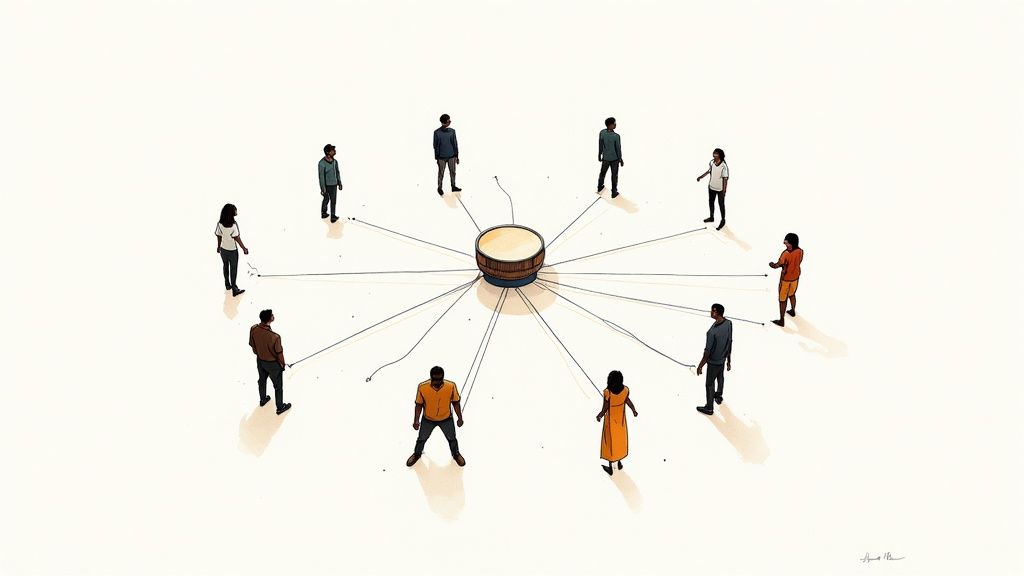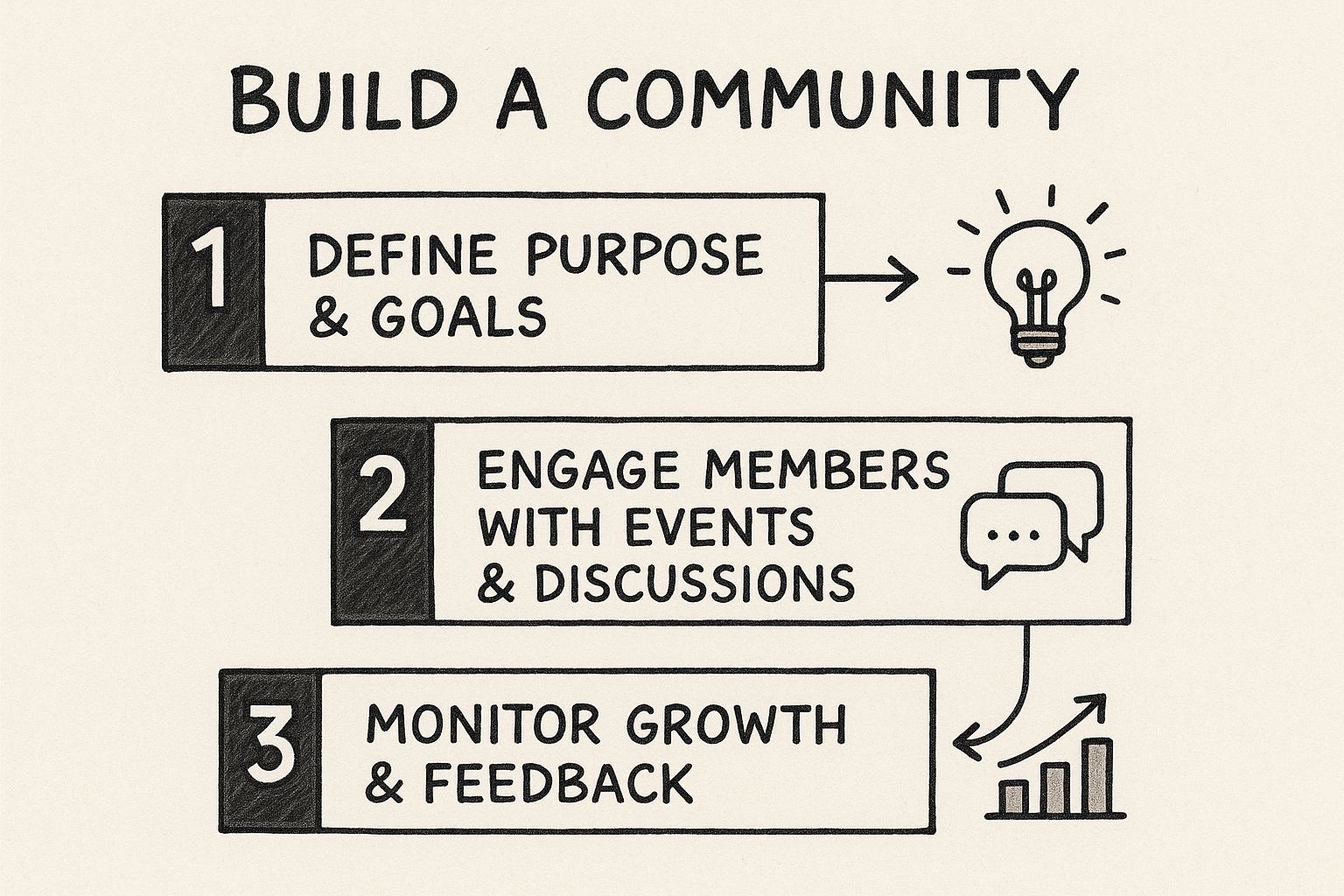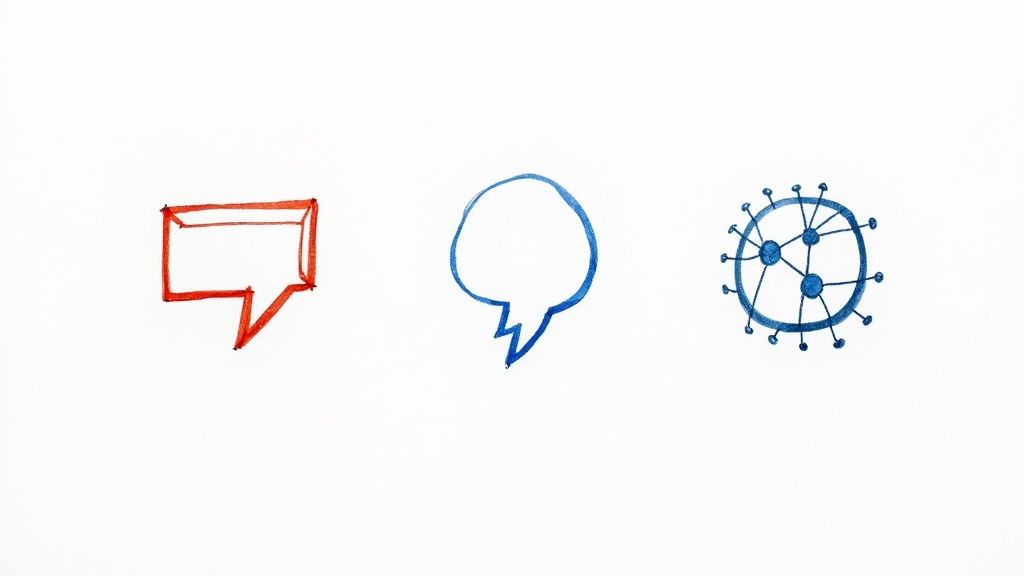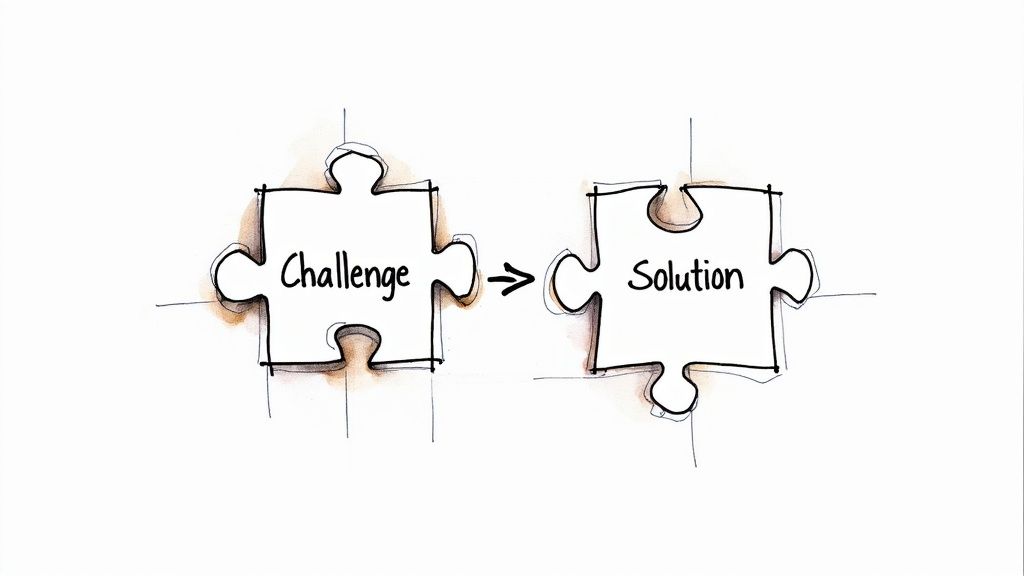What Is Community Building and Why It Matters for Growth
Forget transactional relationships. Community building is the art of creating a space where customers feel like they belong, turning them from passive buyers into your brand's biggest fans. It's about ditching the one-way monologue and starting a real conversation.
Understanding Community Building
So, what is community building, really?
Think of it this way: a vending machine is transactional. Your favorite coffee shop is a community. One just spits out a product. The other is a hub for connection, conversation, and fierce loyalty. You're not just selling to an audience; you're building an ecosystem where people connect with your brand and, more importantly, with each other.
This isn't a soft, feel-good tactic; it's a hard-nosed business strategy. An audience listens. A community participates, contributes, and co-creates. That level of engagement builds a competitive moat around your business that rivals can't just copy. It turns your customer base into your most valuable asset.

Let's cut the fluff and look at the two models side-by-side.
Community Building At a Glance
Aspect | Transactional Model (The Vending Machine) | Community Model (The Coffee Shop) |
|---|---|---|
Relationship | One-off, anonymous. It’s all about the sale. | Ongoing, personal. It's about belonging. |
Communication | One-way broadcast. "Buy our stuff!" | Two-way dialogue. "What do you think?" |
Customer Role | Passive consumer. Buys and leaves. | Active participant. Contributes, shares, and advocates. |
Value | Purely product-based. Is the soda cold? | Beyond the product. Shared experience, support, and identity. |
Loyalty | Price-driven. The cheapest option wins. | Relationship-driven. Built on trust and shared values. |
See the gap? One is a short-term play. The other is a long-term investment in people.
The Strategic Importance of Connection
Why does this matter now more than ever? Because people are sick of being sold to. They crave real connection. Building a community taps directly into this fundamental human need, and the business results are undeniable.
A community gives you a direct line to your users for unfiltered feedback, a built-in support network that cuts costs, and a loyal army of advocates who amplify your message better than any ad ever could.
The data doesn't lie. A massive 86% of businesses now see community as essential. Brands with active communities report a 53% higher customer retention rate, and 76% of consumers are more likely to buy from companies that foster these connections. Dive into more community management trends to see just how big this shift is.
Ultimately, community building creates value that goes way beyond your product. It’s about building relationships that last and giving people a reason to stick around long after the first sale.
The Three Pillars of a Thriving Community
Building a community is like building a house. You can't just throw up some walls and call it done; you need a rock-solid foundation. In the world of community, that foundation rests on three pillars. Get these right, and you've built something that lasts. Get them wrong, and the whole thing crumbles.
These pillars aren't abstract theories. They are the active ingredients that turn a loose group of strangers into a loyal tribe. Let’s break them down.
The First Pillar: Shared Identity
The first and most critical pillar is Shared Identity. This is the "why" that brings everyone together. It’s the common interest, shared passion, or mutual mission that instantly connects every member. It's the flag everyone is proud to rally behind.
For a software company, it might be an obsession with open-source code. For a fitness brand, a collective drive to crush personal limits. This shared identity gives new members an immediate sense of belonging—that "I've found my people" feeling.
A strong shared identity is the emotional glue. It answers the question, "Why am I here?" and makes members feel like part of something bigger than themselves.
Without a clear "why," a community is just a room full of people with nothing to talk about.
The Second Pillar: Meaningful Interactions
Next up: Meaningful Interactions. If identity is the "why," interaction is the "how." This pillar is all about action. It’s the rituals, events, and conversations that let members connect with each other and the brand. It’s where shared identity comes to life.
These interactions aren't random. They're designed.
Weekly Q&A sessions with an industry pro.
Member-led workshops to share unique skills.
Daily discussion prompts that spark lively debate.
Annual in-person meetups that forge real-world bonds.
The key is facilitating connection, not just broadcasting information. Give members a reason to show up and participate. It’s the difference between a silent library and a buzzing workshop.
The Third Pillar: Mutual Value
Finally, the third pillar is Mutual Value. This is the tangible benefit that members give and get. A healthy community is never a one-way street; it's a dynamic ecosystem of exchange.
Members might get exclusive content or early access to products. In return, they provide invaluable feedback, create user-generated content, and become your most powerful brand advocates. A core part of this value exchange involves defining essential roles for a vibrant Discord community, ensuring everyone can contribute and benefit.
When all three pillars—Shared Identity, Meaningful Interactions, and Mutual Value—are standing strong, you create a powerful, self-sustaining cycle. Members join for the identity, stay for the interactions, and contribute because of the value they both give and receive. This is the blueprint for a community that thrives.
Your Actionable Community Building Framework
Theory is great, but execution is everything. Knowing the pillars is one thing; building the house is another.
This is your repeatable blueprint—a practical framework to take you from a blank slate to a buzzing community. Follow these steps to launch with impact.
Stage 1: Define Your Mission
Before you write a single welcome post, you need a North Star.
Your community mission is a clear, concise statement answering one question for potential members: "What's in it for me?" It’s the promise you make.
Don't overthink it. A great mission statement is:
Action-oriented: Focuses on what members will do or achieve.
Specific: Defines the target audience and the primary benefit.
Inspiring: Creates a sense of shared purpose that pulls people in.
A weak mission: "A place for SaaS founders." A strong mission: "A private community for bootstrapped SaaS founders to share growth tactics, overcome challenges, and scale to $10k MRR and beyond." The second one makes a tangible promise.
Stage 2: Identify Your Founding Members
You can't build a community alone. Your first 10-20 founding members are your kindling. These aren't random users; they are the people who are already passionate about your mission.
Find them on other platforms, creating content, and acting as natural connectors. Personally invite them and treat them like VIPs—because they are. Their initial energy sets the tone for everyone who follows.
Stage 3: Choose the Right Platform
Where will your community live? The platform you choose shapes the entire member experience. This isn't just a technical decision; it's a cultural one.
The right platform accelerates growth; the wrong one creates friction that kills engagement. The table below breaks down the top options to help you find the perfect fit.
Choosing Your Community Platform
Platform | Best For | Key Feature | Potential Drawback |
|---|---|---|---|
Real-time chat, small-to-medium tech-savvy groups. | Instant, channel-based conversations; deep integrations. | Conversations get lost; not ideal for searchable content. | |
Gaming communities, Web3 projects, highly interactive groups. | Voice channels, robust moderation tools, younger user base. | Can feel chaotic for less technical users. | |
Circle | Course creators, coaches, and brands wanting a polished, all-in-one hub. | Blends forums, events, and courses in a clean interface. | Higher price point; overkill for simple communities. |
Facebook Groups | Reaching a broad, non-technical audience where they already are. | Massive user base and zero cost to start. | Noisy UI and you don't own the platform or data. |
Deep, long-form discussions and knowledge bases. | Excellent for SEO and creating a searchable content archive. | Requires more technical setup and self-hosting. |
Ultimately, the best platform serves your mission and feels natural to your members. Just ask them where they'd prefer to hang out.
This infographic breaks down the essential steps to get your community off the ground, regardless of your chosen platform.

The core loop is simple: set goals, create engagement, then listen and adapt.
Stage 4: Launch with Impact
A quiet launch is a dead launch. Kick things off with a bang to generate initial momentum. Plan a launch event or a series of activities that immediately deliver on your community's promise.
Fire off some ideas:
An "Ask Me Anything" (AMA) with an industry expert.
A "Founder Showcase" where members share what they're building.
A 7-day challenge focused on a key skill.
The goal is to create immediate value and spark those first crucial interactions.
Don’t just open the doors and hope for the best. Engineer the initial experience to be so valuable that your founding members can’t help but talk about it.
Stage 5: Nurture and Scale
Your work isn't done after launch—it’s just beginning. The final stage is all about nurturing engagement and creating systems for growth.
This means creating weekly rituals, celebrating member contributions, and actively asking for feedback. As you grow, empower your founding members to become advocates. A great way to do this is with referral programs. Find inspiration in these powerful referral marketing strategies to spark organic growth.
This is how you transform your community from something you manage into a self-sustaining ecosystem.
How to Spark Real Community Engagement
An empty community is a ghost town. Real community building lives and dies by engagement. It's the lifeblood that turns passive members into active participants. Without it, you've just built a fancy database.
Engagement isn't magic. It's the result of intentional design. It’s about building systems and rituals that pull members back in, again and again.
Let's ditch wishful thinking and get into a playbook that works.

Engineer Connection from Day One
Your first interaction with a new member sets the tone. A generic "welcome" message is a massive missed opportunity. You need a personalized onboarding experience that makes them feel seen instantly.
This isn't just a hunch. 80% of consumers are more likely to do business with a brand that offers personalized experiences. Smart community managers use data to create custom onboarding flows that make people feel like they belong from the second they join. See more on these community management trends on Bevy.com.
A powerful onboarding sequence could look like this:
A direct message asking about their single biggest goal.
A "start here" post that tags them and points them to a relevant channel.
An invitation to a weekly newcomers' call.
This isn't just about being friendly. It’s about showing a new member how to win, fast.
Create Predictable Engagement Rituals
Consistency builds culture. The best communities have weekly rituals their members can count on. These predictable events become the heartbeat of your community, giving people a reason to show up.
Don't wait for engagement to happen. Schedule it. Rituals turn passive scrolling into active participation by creating a reliable cadence for connection.
These rituals don't need to be complicated. Simple, repeatable formats work best:
Monday Wins: A thread where members share a win from the past week.
Wednesday Wisdom: A Q&A with a guest expert or a senior member.
Feedback Friday: A space for members to share projects and get honest feedback.
These simple hooks give members a clear reason to log in and contribute. When planning these events, think about how you’ll get the word out. To keep everyone in the loop, check out our guide on how to build email lists.
Empower Members to Lead
The end goal is a self-sustaining ecosystem. You get there by shifting from "sage on the stage" to "guide on the side." The key is empowering your most active members to take real ownership.
Encourage and support member-led events—local meetups, specialized workshops, or study groups. When members start creating value for each other, you've unlocked a powerful growth loop.
Celebrate their contributions publicly, give them special roles, and hand them the resources they need to succeed. This is how you transform your community from a top-down broadcast into a vibrant, member-driven network.
Turning Your Community Into a Growth Engine
A great community does more than rack up likes; it rewires your entire business. This is the core idea behind Community-Led Growth (CLG), a strategy that flips the old marketing playbook on its head.
Forget shouting your message at people. CLG is about finding your most passionate members and handing them a megaphone.
Instead of pouring money into ads, you invest in relationships. Your community becomes a self-powering engine where people advocate for you, create incredible content, and offer priceless product feedback. They stop being customers and start acting like co-creators.
Community-Led Growth isn't just another marketing tactic; it's a different way of thinking. It's built on the belief that your most valuable asset isn't your ad budget—it's the trust and enthusiasm of the people who believe in what you're doing.
When you get this right, your community shifts from an expense line to your single most powerful growth channel, pulling in new users and keeping them for the long haul.
Putting CLG Into Action
So how do you actually do it? Start by building programs that recognize and reward the people who show up for you. Give them the tools and the platform to share their stories, which in turn, tells your brand's story for you.
Here’s how to get the ball rolling:
Build an Ambassador Program: Find your super-users—the ones always commenting, helping others, and sharing your stuff. Give them an official title and exclusive perks like early access, a direct line to your product team, or cool swag. They become your volunteer marketing army.
Launch a Member-Generated Content Initiative: Run contests or create a regular showcase for content made by your members—tutorials, case studies, or even fan art. Every piece is powerful social proof you could never buy.
Create a Feedback Loop: Build a system for how you collect, acknowledge, and act on member feedback. When people see their ideas shaping your product, their sense of ownership skyrockets.
These programs don't just appear. They need structure and a commitment to making your members the heroes of the story.
The Self-Sustaining Growth Loop
The real magic of CLG kicks in when it creates a self-sustaining cycle. New people are pulled in by authentic posts from existing members, they have a great experience, and then they're inspired to contribute themselves.
This advocacy is far more believable and effective than any polished ad campaign.
Take Discord, for example. Their explosive growth came from empowering users to build their own thriving ecosystems. They didn't just market a product; they handed over the keys. You can learn more about this strategy and the rise of community-led growth on Delivered Social.
By putting community first, you're not just getting customers; you're building a loyal base that sticks around. It's a fundamental piece of the puzzle if you want to understand how to increase customer retention and build a business that lasts.
Ultimately, you create a brand people don't just buy from—they belong to it.
Common Community Building Mistakes and How to Fix Them
Every community builder messes up. Even with a perfect plan, it’s easy to fall into traps that kill your momentum and leave members ghosting you.
Knowing these pitfalls is your best defense. Let’s break down the mistakes I see over and over—and more importantly, how to get back on track. This isn't about avoiding failure; it's about failing smart and recovering fast.

Mistake 1: Obsessing Over Vanity Metrics
This is the big one: chasing a massive member count instead of real engagement. Having 10,000 silent members is worthless compared to 100 people who actually talk to each other. This obsession creates a shallow space that feels more like an email list than a community.
The Fix: Stop counting heads and start counting conversations. Shift your focus from quantity to quality. Track metrics that actually matter:
Engagement Rate: What percentage of members are posting, commenting, or reacting weekly? That's your pulse.
Member-Led Initiatives: How many conversations or events are started by members, not just you? This shows real ownership.
Response Time: How quickly does a new member's first post get a reply? A fast, warm welcome is everything.
Mistake 2: Treating It Like a Sales Channel
Nothing kills a community faster than aggressive, tone-deaf sales pitches. The moment members feel like they’re just prospects in a funnel, trust evaporates. The space is no longer safe; it’s just another marketing channel to ignore.
A community is for building relationships, not closing deals. The sales will come as a byproduct of the trust and value you create, not from direct promotion.
The Fix: Live by the 90/10 rule. A minimum of 90% of your content must be purely valuable, educational, or conversational. Only then can you sprinkle in the 10% that’s promotional. You have to earn the right to sell by giving, giving, and giving some more.
Mistake 3: Lacking Clear Guidelines
A community without clear rules isn't "free"—it's chaotic. It quickly devolves into spam, off-topic rants, and self-promotion. New members get confused and bail, while your best contributors get drowned out and leave.
The Fix: Create and pin a simple set of guidelines from day one. Frame them positively—talk about the behaviors you want to see, not just a list of "don'ts." And here’s the most important part: consistently and fairly enforce them. This shows you’re serious about protecting the culture.
Common Community Questions, Answered
Got a few nagging questions? Perfect. Let's tackle the most common ones.
How Do I Actually Measure the ROI of a Community?
Track two things: hard numbers and soft signals. For hard ROI, look at higher customer retention, increased lifetime value (LTV), and lower customer acquisition costs from referrals.
But don't ignore the qualitative wins. Are you getting a constant stream of product feedback? Is brand sentiment positive? Is your community creating content for you? The trick is to always connect community activities back to real business goals.
Seriously, How Much Time Does This Take?
In the beginning, a lot. Expect to personally spend 5-10 hours a week inside your community setting the tone. Your hands-on involvement is non-negotiable early on.
Later, you can bring in moderation tools and empower trusted members to help. But even then, a visible presence from leadership is what keeps a community healthy for the long haul.
What’s the Real Difference Between a Community and an Audience?
An audience is a one-way street. You talk, they listen (maybe). A community is a web of two-way conversations.
An audience listens to you. A community talks to each other.
Members don't just engage with the brand; they actively connect with each other. That peer-to-peer bond is the secret sauce. It's what separates a passive following from a true community.
At Viral Marketing Lab, we give you the blueprints and tools to build a community that actually drives growth. Explore our resources today and start turning your audience into your greatest asset.










